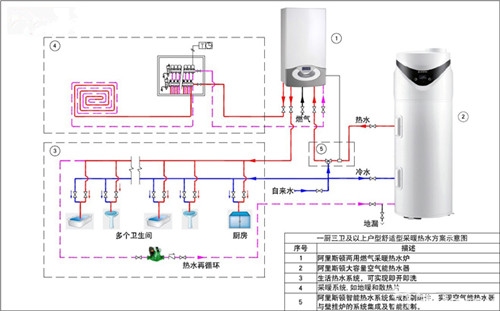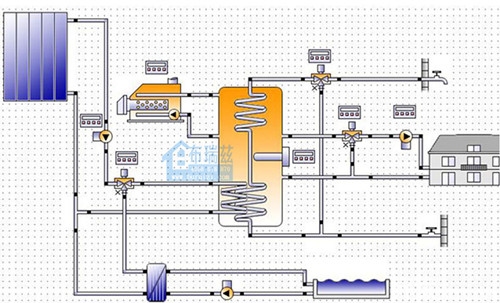In each home, heating is not uncommon. Perhaps our colleagues and friends also introduced us to the installation of heating. Indeed, it is important to choose what brand of system heating is used because of the comfort of our use of heating, but we One of the most easily overlooked points is the installation of home heating systems . As the saying goes: Three-point products, seven-point installation, it can be seen that installation is one of the decisive factors that affect our use of the results later. Let's learn how to install the home heating system .

How to install the home heating system
Heating systems can be installed in a variety of ways but they must comply with common principles. The installation method is as follows:
The first principle: to ensure the cyclic pressure of the system, ie
1. Radiator is higher than the height of the stove, generally calculated from the height center of the radiator, and is not less than 0.5 meters away from the center of the water jacket of the stove;
2. The height of the backwater transverse pipe from the radiator should be as high as possible to facilitate the production of additional additional circulating pressure.
Second Principle: Reduce the Circulation Resistance of the System
1, the pipeline is shorter??
2, thicker diameter;
3, resistance links (such as elbows, valves, etc.) less;
4. When the return pipe is around the door, it is best to bypass the door. When winding from under the door, the lower winding height should be as close as possible. In short, reducing the cyclical resistance comes down to the words "short, thick, small, near."

The third principle: to ensure that there is no air in the system
1. All slopes should have a grade gradient so that the blisters do not stay at any level of pipe, generally about one percent. The direction of the horizontal tube slope of the Sheung Shui can be arbitrary, and the direction of the backwater transverse tube slope is set well along the water flow, so as to avoid the possibility of air bubbles entering the oven and causing local vaporization.
2. All the bosses are equipped with exhaust gas. The so-called "bosses" are those parts of the pipeline that are higher than before and after. Exhaust method can add exhaust valve or simply set up a pipe.
In simple terms, to prevent gas in the system, it should be "one slope and two rows."
In general, the “two heightsâ€, “short and coarse near,†and “one slope and two rows†are the key words for the normal circulation of home heating systems.
As for the expansion tank, it can be connected to the system's upper water cross pipe, back water cross pipe or any part of the system, without any direct impact on the water circulation. Only at the highest point, it can be used as exhaust gas. When the expansion tank is taken out of the return pipe, the system can drain the air when the water is put on the system.

Home Heating System Installation Procedure
Home Heating System - Heating Pipeline
Heater piping is divided into exposed and concealed installations. Outbound installations refer to pipes that are exposed to the outside. Concealed installations are pipes that are hidden under the ground and in the ceiling. In order to obtain the best heat dissipation effect, occupy as little indoor space as possible and present a beautiful decorative effect. It is necessary to properly arrange the position of the radiator and the pipeline alignment. Professional designers will try to make the pipeline laying more reasonable and more concealed.
Home Heating System - Radiator Installation
When the radiator is installed, the radiator must be placed smoothly. Connect the valve connector with the inlet and outlet valve. Use a level ruler to measure whether the radiator is straight and whether the pipe installation meets the requirements. Then use a pipe wrench to tighten the connector.
Home Heating System - Wall Mounted
Wall-hung boilers are the source of heat sources and should be placed in places where there is a source of water or gas. However, they should be separated from the open-wire and electrical equipment during installation, and flammable and explosive materials should not be placed around them. Specifically, boilers The distance from the gas meter and gas stove should be more than 300mm.
Home Heating Systems - Stress Testing, Customer Acceptance
After the radiator and boiler are installed, the entire system must be flushed to make the system clean and free of impurities. The next step is to conduct a stress test. First, close the main valve and open the radiator inlet valve with a pressure test device. When the experimental pressure is 1.5 times the normal operating pressure and not less than the experimental pressure of the entire community network, Normal, the general test 3-5 minutes without leakage is qualified.
Editor's summary: The above is the home heating system installation steps to explain your home heating "insurance" related to the introduction, the location of the installation is not to be underestimated, in order to be more secure, we use more effective, we should carefully read the specific installation of home heating system Steps, please install professional installation personnel to ensure our safety and health.
Heating Installation Renovation Steps Home Audio & Video Renovation House Steps Renovation Steps & Budget
Intelligent Control Butterfly Valve
ZHEJIANG HESHUO TECHNOLOGY CO.,LTD , https://www.hosuocn.com
